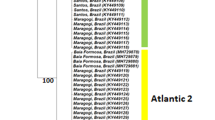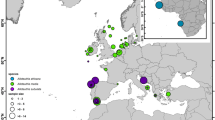Abstract
The jellyfish Aurelia aurita (Linnaeus, 1758) is usually considered to be a cosmopolitan species. Aurelia sp. medusae observed at Foster City, San Francisco Bay, California, USA, since 1988 are morphologically distinct from Aurelia sp. collected 200 km away in Monterey Bay, but are morphologically similar to aquarium-cultured Aurelia sp. from Japan. They differ consistently in radial canal morphology. In allozyme electrophoresis, significant differences at 12 of 14 polymorphic loci strongly suggest that Aurelia sp. from Foster City and Tokyo Bay belong to one species, while Aurelia sp. from Monterey Bay and Vancouver Island belong to a second species. We propose that Aurelia sp. at Foster City is a recent introduction, possibly from Japan via ships' ballast water. The identities and taxonomic affinities of the two Aurelia defined in this study, and their relationships with the Linnaen A. aurita described from the North Atlantic, will require genetic and morphological study of the currently recognized species A. aurita and A. limbata (Brandt, 1838) from several zoogeographical provinces.
Similar content being viewed by others
References
Aebersold PB, Winans GA, Teel DJ, Milner GB, Utter FM (1987) Manual for starch gel electrophoresis: a method for the detection of genetic variation. NOAA tech Rep US Dep Commerce 61: 1–19
Avise JD (1975) Systematic value of electrophoretic data. Syst Zool 23: 465–481
Ayala FJ (1983) Enzymes as taxonomic characters. In: Oxford GS, Rollinson D (eds) Protein polymorphism: adaptive and taxonomic significance. Academic Press, New York, pp 3–26
Ayre DJ, Veron JEN, Dufty SL (1991) The corals Acropora palifera and Acropora cuneata are genetically and ecologically distinct. Coral Reefs 10: 13–18
Bigelow HB (1913) Medusae and siphonophorae collected by the U.S. fisheries steamer “Albatross” in the northwestern Pacific, 1906. Proc US natn Mus 44: 98–100
Bucklin A (1985) Biochemical genetic variation, growth and regeneration of the sea anemone, Metridium, of British shores. J mar biol Ass UK 65: 141–157
Bucklin A, Hedgecock D (1982) Biochemical genetic evidence for a third species of Metridium (Coelenterata: Actiniaria). Mar Biol 66: 1–7
Buss LW, Yund PO (1989) A sibling species group of Hydractinia in the north-eastern United States. J mar biol Ass UK 69: 857–874
Carlton JT (1979) Introduced invertebrates of San Francisco Bay. In: Conomos TJ (ed) San Francisco Bay: the urbanized estuary. California Academy of Sciences, San Francisco, pp 427–444
Carlton JT (1987) Patterns of transoceanic marine biological invasions in the Pacific Ocean. Bull mar Sci 41: 452–465
Carlton JT, Thompson JK, Schemel LE, Nichols FH (1990) Remarkable invasion of San Francisco Bay (California, USA) by the Asian clam Potamocorbula amurensis. I. Introduction and dispersal. Mar Ecol Prog Ser 66: 81–94
Day RW, Quinn GP (1989) Comparisons of treatments after an analysis of variance in ecology. Ecol Monogr 59: 433–463
Garthwaite RL, Potts DC, Veron JEN, Done TJ (1994) Electrophoretic identification of Poritid species (Anthozoa: Scleractinia). Coral Reefs 13: 49–56
Grassle JP, Grassle JF (1976) Sibling species in the marine pollution indicator Capitella (Polychaeta). Science, NY 192: 567–569
Greenberg N (1992) Biochemical and morphological evidence for a newly introduced species of Aurelia in San Francisco Bay, California M.S. thesis. San Jose State University, San Jose, Calif
Hamner WM, Jenssen RM (1974) Growth, degrowth, and irreversible cell differentiation in Aurelia aurita. Am Zool 14: 833–849
Knowlton N, Weil E, Weight L, Guzman HM (1992) Sibling species in Montastraea annularis, coral bleaching, and the coral climate record. Science. NY 255: 330–333
Kozloff EN (1974) Keys to the marine invertebrates of Puget Sound, the San Juan Archipelago, and adjacent regions. University of Washington Press, Seattle
Kozloff EN (1987) Marine invertebrates of the Pacific Northwest. University of Washington Press, Seattle
Kramp PL (1961) Synopsis of the medusae of the world. J mar biol Ass UK 40: 337–342
Mainland D, Herrera L, Sutcliffe MI (1956) Statistical tables for use with binomial samples — contingency tests, confidence limits, and sample size estimates. New York University College of Medicine, Department of Medical Statistics, New York
Matsueda N (1969) Presentation of Aurelia aurita at thermal power station. Bull mar biol Stn Asamushi 13: 187–191
Mayer AG (1910) The Scyphomedusae. Vol. III. In: Medusae of the world. Carnegie Institution of Washington, Washington, D.C., pp 603–630
Murphy RW, Sites JW Jr, Buth DG, Haufler CH (1990) Proteins. I. Isozyme electrophoresis. In: Hillis DM, Moritz C (eds) Molecular systematics. Sihaur Associates, Sunderland, Mass, pp 45–126
Nei M (1978) Estimation of average heterozygosity and genetic distance from a small number of individuals. Genetics, Austin, Tex 89: 583–590
Ostman C (1982) Isoenzymes and taxonomy in Scandinavian hydroids (Cnidaria, Campanulariidae). Zool Scr 11: 155–163
Papathanassiou E, Panayotidis P, Anagnostaki K (1987) Notes on the biology and ecology of the jellyfish Aurelia aurita Lam. in Elefsis Bay (Saronikos Gulf, Greece). Pubbl Staz Zool Napoli: (I. Mar Ecol) 8: 49–58
Russel FS (1970) The medusae of the British Isles. Vol. 2. Cambridge University Press, New York
Selander RK, Smith MH, Yang SY, Johnson WE, Gentry JB (1971) Chap. IV. Biochemical polymorphism and systematics in the genus Peromyscus. I. Variation in the old field mouse (Peromyscus polionotus). Stud Genet, Austin, Tex 7103: 49–90
Shaw PW, Beardmore JA, Ryland JS (1987) Sagartia troglodytes (Anthozoa: Actiniaria) consists of two species. Mar Ecol Prog Ser 41: 21–28
Shenker JM (1984) Scyphomedusae in surface waters near the Oregon coast, May-August 1981. Estuar cstl Shelf Sci 19: 619–632
Sloan NA, Gunn CR (1985) Fishing, processing, and marketing of the jellyfish (Aurelia aurita L.) from southern British Columbia. Can Industry Rep Fish aquat Sciences 157: 1–29
Smith BL, Potts DC (1987) Clonal and solitary anemones (Anthopleura) of western North America: population genetics and systematics. Mar Biol 94: 537–546
Sole-Cava AM, Thorpe JP (1992) Genetic divergence between colour morphs in populations of the common intertidal sea anemones Actinia equina and A. prasina (Anthozoa: Actiniaria) in the isle of Man. Mar Biol 112: 243–252
Sole-Cava AM, Thorpe JP, Kaye JG (1985) Reproductive isolation with little genetic divergence between Urticina (= Tealia) felina and U. eques (Anthozoa: Actiniaria). Mar Biol 85: 279–284
Stobart B, Benzic JAH (1994) Allozyme electrophoresis demonstrates that the scleractinian coral Montipora digitata is two species. Mar Biol 118: 183–190
Stoddart JA (1983) Asexual production of planulae in the coral Pocillopora damicornis. Mar Biol 76: 279–284
Thorpe JP (1983) Enzyme variation, genetic distance and evolutionary divergence in relation to levels of taxonomic separation. In: Oxford GS, Rollinson D (eds) Protein polymorphism: adaptive and taxonomic significance. Academic Press, New York, pp 131–152
Uchida T (1954) Distribution of scyphomedusae in Japanese and adjacent waters. J Fac Sci Hokkaido Univ (Ser 6) 12: 209–219
Weil E, Knowlton N (1994) A multi-character analysis of the Caribbean coral Montastraea annularis (Ellis and Solander, 1785) and its two sibling species, M. faveolata (Ellis and Solander, 1786) and M. franksi (Gregory, 1895). Bull mar Sci 55: 151–175
Wildermuth J (1989) Foster City's hard line against its jellyfish. San Francisco Chronicle, 3 Aug. 1989, p A3
Winer BJ (1971) Statistical principles in experimental design. McGraw-Hill. New York
Zar JH (1984) Biostatistical analysis. Prentice-Hall, Englewood Cliffs, New Jersey
Author information
Authors and Affiliations
Additional information
Communicated by J.P. Grassle, New Brunswick
Rights and permissions
About this article
Cite this article
Greenberg, N., Garthwaite, R.L. & Potts, D.C. Allozyme and morphological evidence for a newly introduced species of Aurelia in San Francisco Bay, California. Marine Biology 125, 401–410 (1996). https://doi.org/10.1007/BF00346320
Received:
Accepted:
Issue Date:
DOI: https://doi.org/10.1007/BF00346320




